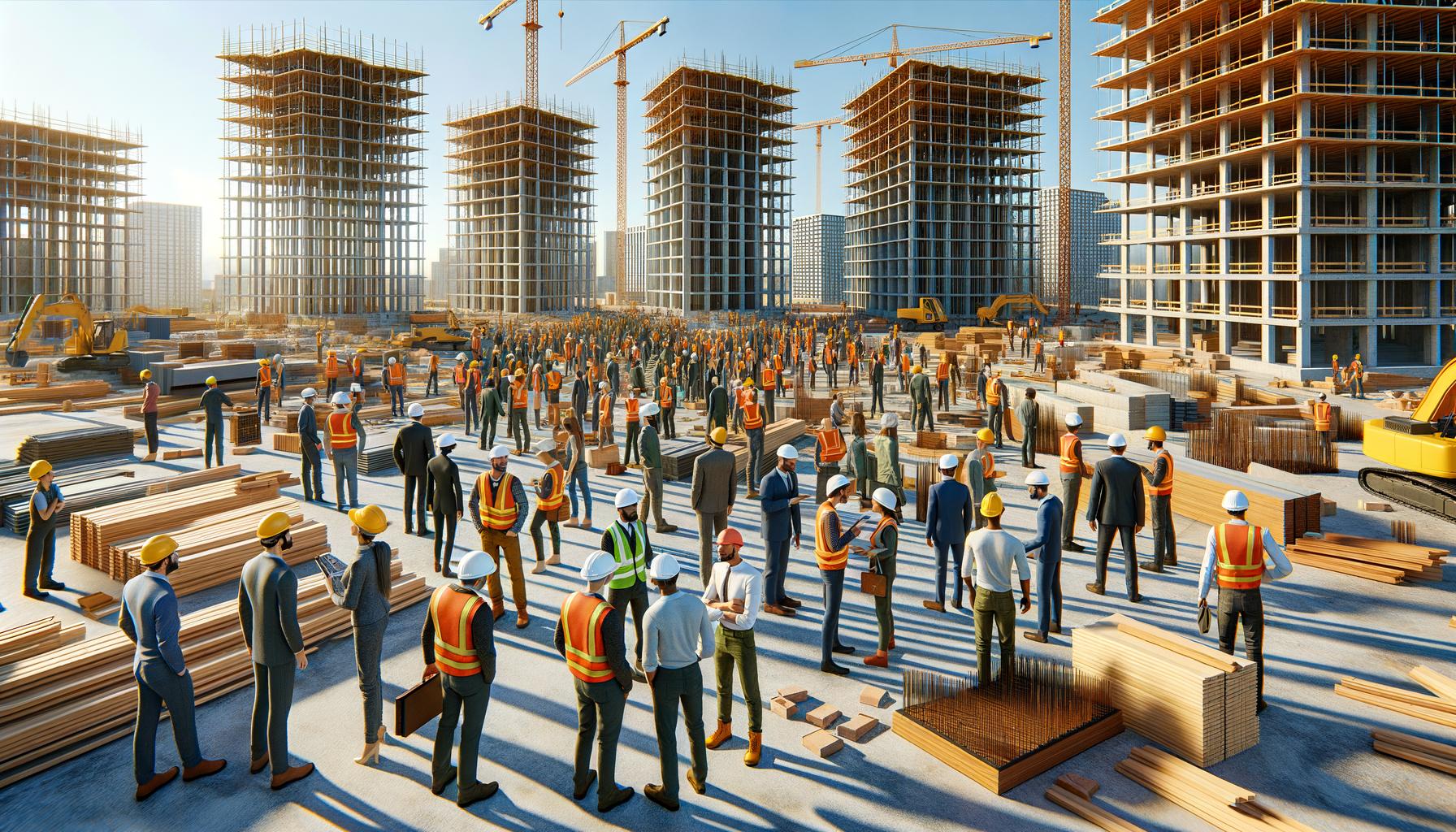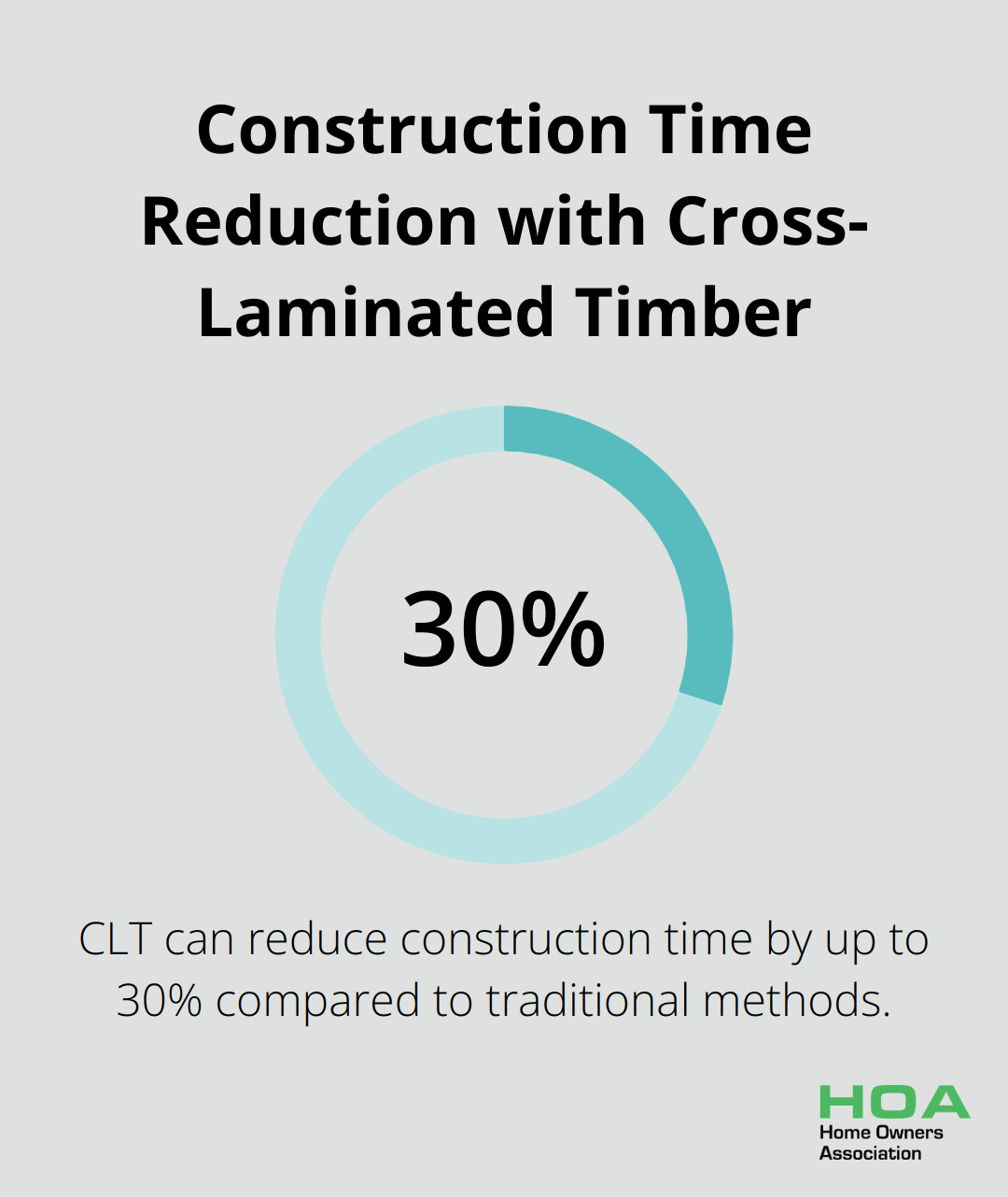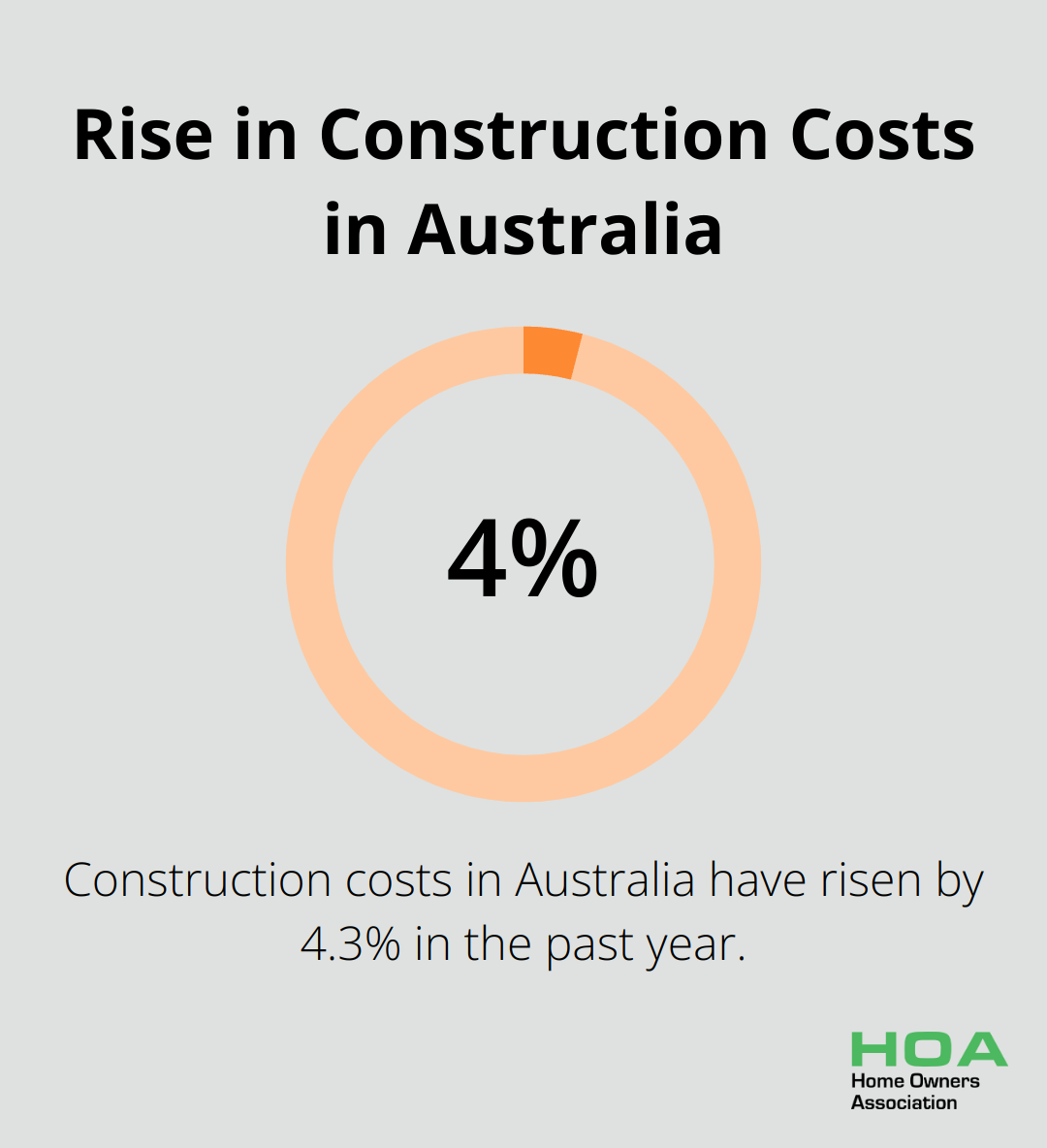
At Home Owners Association, we understand the importance of using reliable building materials for your home projects. Choosing the right materials can make a significant difference in the longevity, safety, and value of your property.
This guide will help you navigate the complex world of building materials, providing insights on how to select the best options for your specific needs and budget.
What Are the Most Common Building Materials?
Concrete: The Foundation of Modern Construction
Concrete stands as a versatile material with centuries of use behind it. Its composition of cement, water, and aggregates (such as sand and gravel) provides strength and durability ideal for foundations, walls, and floors. Fire-resistant and weather-hardy, concrete suits Australia’s diverse climate perfectly.
The cement industry, however, contributes significantly to global CO2 emissions (about 8% according to the International Energy Agency). To address this environmental concern, many Australian builders now turn to eco-friendly alternatives like geopolymer concrete, which can reduce CO2 emissions significantly from the cement industry.

Steel: Strength and Flexibility Combined
Steel’s high strength-to-weight ratio makes it an excellent choice for large-scale structures and reinforcing other materials. Commercial buildings and high-rise apartments often utilize steel extensively. Its 100% recyclability offers a substantial advantage from a sustainability perspective.
Steel production does present challenges due to its energy-intensive nature and carbon emissions. The industry responds with innovations such as electric arc furnaces powered by renewable energy to mitigate these environmental concerns.
Wood: A Renewable Resource with Character
Wood, a traditional building material, experiences a resurgence in modern construction. As a renewable resource with a low carbon footprint and excellent insulation properties, sustainably sourced timber grows increasingly popular in Australia for both structural and aesthetic purposes.
Engineered wood products, like cross-laminated timber (CLT), revolutionize the industry. This process not only reduces carbon footprint but also promotes responsible forest management. Forest and Wood Products Australia reports that CLT can reduce construction time by up to 30% compared to traditional methods.

Glass: Transparency and Energy Efficiency
Glass plays a vital role in modern architecture, offering transparency, natural light, and energy efficiency. Advanced glazing technologies (such as low-emissivity coatings and double or triple-pane windows) enhance thermal performance and reduce energy consumption.
In Australia’s varied climate, the right glass selection can significantly impact a building’s energy efficiency. For instance, spectrally selective glass can block heat while allowing visible light to pass through, which proves particularly useful in warmer regions.
Plastics: Versatility in Construction
Plastics find numerous applications in construction due to their versatility, durability, and cost-effectiveness. From PVC pipes and insulation to synthetic roofing materials, plastics offer lightweight alternatives to traditional materials.
While concerns about environmental impact exist, the industry develops more sustainable options. Recycled plastics and bio-based polymers represent steps towards reducing the environmental footprint of plastic building materials.
The selection of building materials significantly influences a project’s success. Factors such as local climate, building codes, and long-term maintenance requirements all play crucial roles in this decision-making process. As we move forward, let’s explore the key factors to consider when selecting these materials for your specific project needs.
What Factors Matter Most When Choosing Building Materials?
Durability in Australia’s Diverse Climate
Australia’s climate varies dramatically from region to region, making durability a top priority. Coastal areas require materials that withstand salt spray and high humidity. Stainless steel fixtures and marine-grade plywood (known for their corrosion resistance) are popular choices in these locations. Inland areas need materials that handle extreme temperature fluctuations and UV exposure.
The Building Code of Australia (BCA) provides specific guidelines for material selection based on climate zones. For instance, in some climate zones, insulation should be installed with due consideration of condensation and associated interaction with adjoining building elements. In bushfire-prone areas, materials must meet strict fire resistance ratings (as outlined in Australian Standard AS 3959). These requirements significantly influence material choices.
Cost-Effectiveness and Long-Term Value
Initial costs matter, but long-term value is equally important. Fiber cement siding might cost more upfront than vinyl, but its durability and low maintenance requirements can lead to significant savings over time.
The Australian Bureau of Statistics reports that construction costs have risen by 4.3% in the past year. This trend emphasizes the importance of balancing upfront costs with long-term benefits. Home Owners Association members benefit from trade pricing, which can help offset these rising costs and make higher-quality materials more accessible.

Compliance with Local Regulations
Each state and territory in Australia has unique building regulations that impact material choices. Energy efficiency requirements vary across the country. For example, Victoria mandates that all new homes must achieve a minimum 6-star energy rating, which influences insulation and glazing choices.
Consultation with local authorities or a licensed builder ensures that material selections comply with all relevant codes. Non-compliance can result in costly modifications or legal issues.
Environmental Impact and Sustainability
Sustainability plays an increasingly important role in construction. The Green Building Council of Australia reports that Green Star Performance is Australia’s leading sustainability rating tool to assess the operational performance of existing buildings.
Material selection should consider embodied energy, recyclability, and overall environmental impact. Recycled steel has a lower carbon footprint than newly produced steel. Sustainably sourced timber (certified by the Forest Stewardship Council) ensures responsible forest management.
Aesthetic Appeal and Design Flexibility
While functionality is important, visual appeal shouldn’t be overlooked. Material choices significantly influence a home’s character and value. Natural stone cladding can add timeless elegance, while modern composite materials offer sleek, contemporary looks.
Some materials, like copper roofing, develop a beautiful patina over time. Others may require regular maintenance to maintain their appearance. Consider how materials will age and weather when making your selection.
The right choice often involves balancing these various considerations to find the optimal solution for your specific project and location. Now that we’ve explored the key factors in material selection, let’s move on to discuss how to source quality building materials from reliable suppliers.
How to Source Quality Building Materials
Research and Compare Suppliers
Create a list of potential suppliers. The Australian Building and Construction Commission (ABCC) maintains a directory of accredited suppliers, which serves as a good starting point. Compare at least three different suppliers for each material you need. Examine factors such as pricing, delivery times, and minimum order quantities.
Verify Quality Standards
Always check that the materials you consider meet Australian Standards. For example, reinforced concrete structures use reinforced steels that have been tested to AS/NZS 4671:2001, Steel reinforcing materials. Request documentation from suppliers proving compliance with these standards.
The Australian Building Codes Board (ABCB) provides a comprehensive list of relevant standards for different building materials. Familiarize yourself with these to make informed decisions.
Evaluate Supplier Reputation
A supplier’s track record indicates their reliability. Look for suppliers with at least five years of experience in the Australian market (as recommended by the Master Builders Association of Victoria). Check online reviews and ask for references from past customers.
Consider suppliers who hold relevant certifications such as ISO 9001 for quality management systems. These certifications show a commitment to maintaining high standards in their operations.
Seek Expert Advice
Consult with industry professionals. Architects, engineers, and experienced contractors can provide valuable insights into material selection based on your specific project needs. They can help you interpret technical specifications and assess the suitability of different materials for your climate and building type.
The Building Designers Association of Australia (BDAA) is the single national association that represents, advocates for, promotes and connects building designers throughout Australia.
Leverage Industry Resources
Try to utilize resources provided by industry associations. These organizations often offer valuable information and tools to help you make informed decisions about building materials. Some associations (like Home Owners Association) may even provide members with access to curated lists of trusted suppliers and negotiated discounts.
Choosing the right building materials is an investment in the long-term value, safety, and sustainability of your property. The Australian construction industry’s strict regulations ensure high standards for building materials. Use these guidelines to source quality materials that meet your project’s specific needs and comply with local regulations.
Final Thoughts
Selecting reliable building materials requires careful consideration of durability, cost-effectiveness, regulatory compliance, environmental impact, and aesthetic appeal. Homeowners must understand the properties and applications of common materials like concrete, steel, wood, glass, and plastics to make informed decisions. The balance between quality, cost, and sustainability plays a vital role in material selection, often leading to substantial long-term savings despite higher initial expenses.
Sourcing quality building materials demands diligence and research. Homeowners should compare suppliers, verify quality standards, evaluate reputations, and seek expert advice to ensure compliance with Australian regulations and industry best practices. Leveraging resources from reputable organizations and industry associations (such as the Building Designers Association of Australia) provides valuable insights throughout the decision-making process.
We at Home Owners Association support Melbourne homeowners in their quest for reliable building materials. Our members access trade pricing, expert advice, and a network of trusted suppliers, which makes home improvement more affordable and manageable. Homeowners who utilize these resources and follow our guidelines can confidently enhance the value, safety, and sustainability of their properties.





